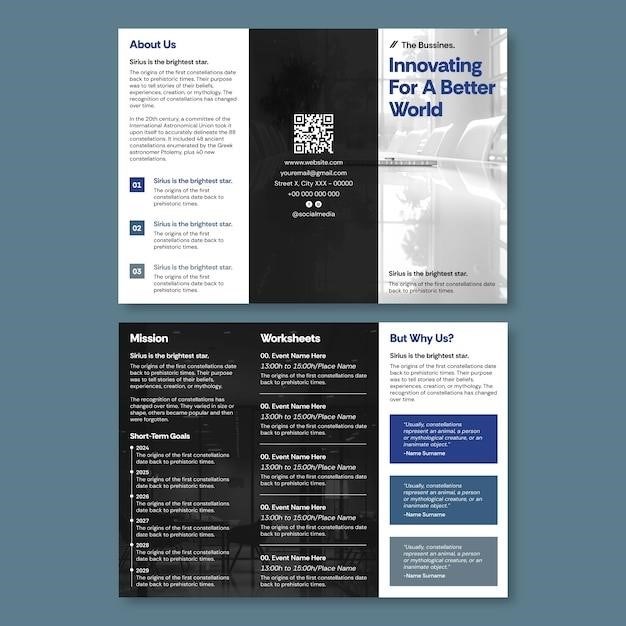monster the book pdf
Monster‚ a New York Times bestselling novel by Walter Dean Myers‚ tells the story of Steve Harmon‚ a teenager on trial for murder‚ blending screenplay and journal formats.
1.1 Background Information About the Author‚ Walter Dean Myers
Walter Dean Myers‚ a celebrated American author‚ was born in 1937 in Martinsburg‚ West Virginia. Growing up in Harlem‚ Myers faced early challenges that shaped his writing. Before becoming a writer‚ he served in the U.S. Army and worked various jobs. Known for his raw‚ realistic portrayals of urban life‚ Myers authored over 100 books‚ many focusing on Teen and Young Adult themes. His works often explored race‚ identity‚ and societal challenges‚ earning him numerous awards and a reputation as a pioneer in Young Adult literature. His novel Monster stands out for its unique narrative style and deep emotional resonance.
1.2 Overview of the Book “Monster”
Monster‚ a multi-award-winning novel by Walter Dean Myers‚ follows Steve Harmon‚ a 16-year-old accused of murder. The story unfolds in a unique screenplay format‚ reflecting Steve’s aspiration to be a filmmaker‚ interspersed with his journal entries. This blend of narrative styles offers a gripping exploration of Steve’s psychological state as he navigates the trial and grapples with his identity. The book delves into themes of justice‚ morality‚ and self-perception‚ making it a powerful coming-of-age story that resonates deeply with young adult readers. Its innovative structure and emotional depth have solidified its place in contemporary literature.
1.3 Importance of the Book in Young Adult Literature
Monster holds significant importance in young adult literature for its unflinching portrayal of systemic injustice and adolescent struggle. Myers tackles themes of identity‚ morality‚ and societal inequality with raw honesty‚ resonating deeply with teenage readers. The book’s unique narrative style and emotional depth make it a compelling resource for classrooms and book clubs‚ fostering critical thinking and empathy. Its recognition with prestigious awards‚ including the Michael L. Printz Award‚ underscores its literary merit and lasting impact on contemporary young adult literature‚ ensuring its relevance for future generations of readers.
Plot Summary of “Monster”
Monster follows Steve Harmon‚ a teenager on trial for murder‚ as he navigates a harrowing legal battle. The story‚ told through a screenplay format‚ explores Steve’s self-reflection and the question of whether he is truly a “monster‚” delving into themes of identity and the consequences of choices.
2.1 The Story of Steve Harmon and His Trial
In Monster‚ Steve Harmon‚ a teenager accused of acting as a lookout in a fatal robbery‚ faces trial‚ grappling with his potential guilt and societal expectations. The narrative‚ presented as a screenplay and journal entries‚ offers a raw‚ intimate glimpse into Steve’s psyche as he navigates the legal system‚ questioning his identity and morality. His aspirations as a filmmaker contrast with the harsh reality of his trial‚ highlighting themes of justice‚ self-perception‚ and the impact of one’s choices. The story challenges readers to consider whether Steve is truly a “monster” or a victim of circumstances.
2.2 The Unique Narrative Style of the Book
Monster stands out for its innovative narrative style‚ blending a screenplay format with journal entries. This dual approach allows readers to experience Steve Harmon’s trial as both an external drama and an internal reflection. The screenplay sections recreate the courtroom scenes with cinematic clarity‚ while the journal entries provide intimate insights into Steve’s thoughts and emotions. This format not only heightens the tension but also deepens the psychological complexity of the story‚ making it a compelling and thought-provoking read. The unique structure underscores the book’s exploration of identity‚ morality‚ and the blurred lines between reality and perception.
2.3 Key Events and Turning Points in the Story
The trial of Steve Harmon is the central event‚ where he faces charges for acting as a lookout in a fatal robbery. A pivotal moment occurs when Steve’s friend‚ King‚ testifies against him‚ revealing their involvement. Steve’s internal conflict intensifies as he grapples with guilt and self-doubt. The death of Mr. Nesbitt‚ the store owner‚ serves as a tragic turning point‚ heightening the legal stakes. Steve’s journal entries reveal his fear of being labeled a “monster‚” while the courtroom drama exposes the harsh realities of justice. The verdict ultimately shapes Steve’s understanding of himself and his future.

Themes Explored in “Monster”
Monster explores themes of justice‚ morality‚ identity‚ and societal pressures‚ delving into the consequences of choices and the struggle to define oneself amidst adversity and judgment.
3.1 The Theme of Justice and Morality
Monster delves into the complexities of justice and morality through Steve Harmon’s trial‚ exploring the fairness of the legal system and Steve’s internal struggle with guilt. The novel examines how societal perceptions shape judgments‚ while Steve grapples with his role in the crime. The screenplay format allows readers to witness the trial’s intensity‚ highlighting moral dilemmas and the consequences of choices. By blending courtroom drama with personal reflection‚ Myers challenges readers to question the true meaning of justice and the moral implications of labeling someone a “monster.” This theme resonates deeply‚ making the book a powerful commentary on societal norms and individual accountability.
3.2 The Struggle with Identity and Self-Perception
Monster explores Steve Harmon’s internal conflict as he navigates his identity amidst the trial and societal expectations. Steve’s aspiration to be a filmmaker contrasts sharply with his criminal label‚ creating a clash between his perceived self and the “monster” others see. Through journal entries and the screenplay format‚ Myers reveals Steve’s struggle to reconcile his past actions with his desire for redemption. The novel highlights the tension between self-perception and external judgment‚ urging readers to question how labels like “monster” shape identities and limit personal growth. This theme underscores the complexity of adolescent self-discovery in the face of societal pressures.
3.3 The Impact of Societal Pressures on Individuals
Monster examines how societal pressures shape Steve Harmon’s experiences and perceptions. The trial and the label of “monster” imposed by others highlight the external forces that define his identity. Myers illustrates how systemic issues‚ such as poverty and racial biases‚ contribute to Steve’s entrapment in a cycle of violence and crime. The novel underscores the tension between personal aspirations and the constraints of societal expectations‚ showing how these pressures can limit opportunities and perpetuate cycles of marginalization. Through Steve’s journey‚ the book critiques the broader societal structures that influence individual outcomes and shape lives like Steve’s. This theme resonates deeply in contemporary discussions of justice and inequality.

Characters in “Monster”
Steve Harmon is the protagonist‚ a teenager on trial for murder‚ struggling with identity and guilt. King is the charismatic figure who influences Steve’s choices‚ while Mr. O’Brien serves as Steve’s mentor‚ offering guidance and support.
4.1 Steve Harmon: The Protagonist’s Journey
Steve Harmon is a teenager on trial for murder‚ navigating a harrowing legal ordeal while reflecting on his life choices. As the protagonist‚ Steve’s journey is deeply personal‚ exploring themes of identity‚ guilt‚ and redemption. His aspirations as a filmmaker are intertwined with the narrative‚ as he envisions his trial as a screenplay. Through journal entries and a unique narrative style‚ Steve grapples with societal expectations and his own morality. The book follows his psychological and emotional growth‚ offering a raw portrayal of a young man caught between innocence and the harsh realities of adulthood. The story highlights Steve’s struggle to define himself amidst overwhelming circumstances.
4.2 King: The Influential Figure in Steve’s Life
King is a pivotal figure in Steve Harmon’s life‚ exerting significant influence over his decisions. Portrayed as a tough and imposing character‚ King is central to the events leading to the robbery and murder trial. Steve’s relationship with King is complex‚ marked by a mix of fear and admiration. King’s leadership role in the crime underscores Steve’s moral dilemma‚ as he grapples with guilt and loyalty. The dynamic between them highlights Steve’s struggle to navigate peer pressure and societal expectations‚ ultimately shaping his journey toward self-awareness and accountability. King’s presence looms large‚ impacting Steve’s perception of himself and his place in the world.
4.3 Mr. O’Brien: The Mentor and His Role
Mr. O’Brien serves as Steve Harmon’s mentor‚ offering guidance and support during his trial. Through their interactions‚ Mr. O’Brien helps Steve reflect on his actions and identity. He encourages Steve to explore his aspirations and confront his fears‚ playing a crucial role in Steve’s emotional and psychological growth. Mr. O’Brien’s mentorship provides a contrast to the negative influences in Steve’s life‚ such as King‚ and helps him navigate the complexities of his situation. His presence is instrumental in Steve’s journey toward self-discovery and understanding the consequences of his choices;
Writing Style and Structure
Monster features a unique screenplay format‚ blending Steve’s journal entries with cinematic dialogue‚ creating a dynamic and reflective narrative that immerses readers in Steve’s legal and personal struggles.
5.1 The Screenplay Format and Its Significance
Monster is uniquely presented in a screenplay format‚ reflecting Steve Harmon’s imagination of his trial as a movie. This style allows readers to witness the legal proceedings and Steve’s internal thoughts simultaneously‚ creating a vivid and immersive experience. The format emphasizes Steve’s struggle to process his reality‚ blending cinematic dialogue with personal reflections. By structuring the narrative this way‚ Myers highlights the blurred lines between truth and perception‚ making the reader an active participant in interpreting the story. This innovative approach enhances the emotional depth and complexity of Steve’s journey‚ making it a compelling and thought-provoking read.
5.2 The Use of Journal Entries in the Narrative
In Monster‚ journal entries serve as a critical narrative device‚ offering intimate glimpses into Steve Harmon’s thoughts and emotions. These entries complement the screenplay format‚ providing a personal counterpoint to the legal drama. Through his journal‚ Steve reflects on his fears‚ doubts‚ and hopes‚ allowing readers to connect with his inner world. The journals also reveal his aspirations as a filmmaker and his desire to make sense of his reality. This dual narrative structure enhances the emotional depth of the story‚ making Steve’s journey feel both authentic and relatable. The journal entries are a powerful tool for character development and thematic exploration in the book.
5.3 The Author’s Approach to Storytelling
Walter Dean Myers captivates readers with a unique storytelling approach in Monster‚ blending cinematic screenplay dialogue and personal journal entries. This innovative method allows the narrative to unfold through Steve Harmon’s dual perspectives: the external legal drama and his internal emotional battles. The screenplay format creates a dynamic‚ immersive experience‚ while the journals offer introspective depth‚ revealing Steve’s fears‚ hopes‚ and aspirations. Myers’s use of this dual narrative not only heightens tension but also delivers a powerful exploration of identity and morality‚ making the book both gripping and thought-provoking.

Awards and Recognition
Monster earned the Michael L. Printz Award‚ ALA Best Book‚ Coretta Scott King Honor‚ and was a National Book Award finalist‚ solidifying its literary acclaim.
6.1 Michael L. Printz Award and Other Accolades
Monster received the prestigious Michael L. Printz Award‚ marking its excellence in young adult literature. It was also honored as an ALA Best Book and a Coretta Scott King Honor selection. These accolades highlight the novel’s profound impact on its audience and its contribution to contemporary literature. The book’s exploration of justice‚ identity‚ and societal pressures resonated deeply‚ earning it a National Book Award finalist status. These recognitions underscore Walter Dean Myers’ mastery in crafting a story that challenges and engages readers‚ solidifying Monster’s place as a landmark in young adult fiction.
6.2 ALA Best Book and Coretta Scott King Honor
Monster earned the distinction of being named an ALA Best Book‚ recognizing its literary excellence and resonance with young adult readers. Additionally‚ it received the Coretta Scott King Honor‚ celebrating its profound portrayal of the African American experience. These accolades highlight Walter Dean Myers’ ability to craft a narrative that not only entertains but also provokes critical thinking about justice‚ identity‚ and societal issues. The book’s impact on young adult literature is further underscored by its inclusion in these prestigious lists‚ solidifying its role as a transformative and thought-provoking read.
6.3 National Book Award Finalist Status
Monster was a National Book Award finalist‚ showcasing its literary merit and emotional depth. This recognition highlighted Walter Dean Myers’ storytelling prowess‚ as the book’s unique format and poignant themes resonated deeply with readers and critics alike. The nomination underscored the novel’s ability to address complex issues such as justice‚ identity‚ and societal pressures‚ making it a standout work in young adult literature. This accolade further cemented the book’s legacy as a powerful and thought-provoking narrative that continues to impact readers worldwide.
Availability of “Monster” in PDF Format
Monster by Walter Dean Myers is widely available in PDF format on platforms like Scribd‚ LitRes‚ and eBook stores‚ offering readers convenient access to this acclaimed novel.

7.1 Sources for Downloading the Book in PDF
The PDF version of Monster can be downloaded from various platforms such as Scribd‚ LitRes‚ and the Internet Archive. Additionally‚ the book is available for purchase in PDF format from major eBook stores like Amazon and Barnes & Noble. Some websites‚ such as Bookey.app‚ offer free previews or samples. Always ensure to download from authorized sources to avoid copyright infringement and support the author and publishers. Legal options provide high-quality versions of the book while respecting intellectual property rights.
7.2 Legal and Ethical Considerations for PDF Downloads
Downloading Monster in PDF format requires adherence to copyright laws. Ensure the source is authorized‚ as pirated copies violate intellectual property rights. Platforms like Scribd‚ LitRes‚ and official eBook stores offer legal access. Unauthorized downloads harm authors and publishers‚ undermining their work’s value. Always choose reputable sites to support ethical practices and avoid legal consequences. Respect copyright to promote fair compensation for creators and maintain the integrity of literary works.
7.3 Popular Platforms Offering the Book in PDF
Monster by Walter Dean Myers is available in PDF format on various platforms. Scribd‚ LitRes‚ and hoopla offer legal downloads‚ ensuring access to the book while supporting authors. The Internet Archive also provides versions‚ though verifying copyright compliance is essential. Official eBook stores like Amazon and Barnes & Noble offer secure purchases. These platforms ensure high-quality formats and contribute to the literary ecosystem by respecting copyright laws. Choose reputable sources to enjoy the book responsibly and support its creators.
Reader Reception and Reviews
Monster has received widespread acclaim for its gripping narrative and thought-provoking themes‚ earning awards like the Michael L. Printz Award and becoming a New York Times bestseller.
8.1 Positive Feedback and Praise for the Book
Monster has garnered widespread critical acclaim for its raw‚ unflinching portrayal of a teenager’s harrowing trial. Readers praise its unique screenplay format‚ which immerses them in Steve Harmon’s world. The book’s ability to explore themes like justice‚ identity‚ and societal pressures resonates deeply with young adult readers. Many educators and reviewers highlight its educational value‚ often incorporating it into school curricula for its thought-provoking narrative. The novel’s multi-award-winning status‚ including the Michael L. Printz Award and Coretta Scott King Honor‚ further solidifies its place as a seminal work in young adult literature.
8.2 Critical Reviews and Controversies
While Monster has received widespread acclaim‚ some critics argue its mature themes and graphic content may not be suitable for all young readers. Debates arise over its suitability in school curricula due to its intense portrayal of violence and legal drama. Despite this‚ the book is praised for its unflinching realism and ability to spark crucial discussions about justice and morality. Its inclusion in banned book lists highlights its controversial nature‚ though supporters argue its value lies in addressing systemic issues and providing a voice for marginalized youth.
8.3 Impact on Young Adult Readers

Monster has had a profound impact on young adult readers‚ offering a raw and relatable portrayal of a teenager navigating a criminal trial. Its unique narrative style‚ blending screenplay and journal entries‚ engages readers and encourages them to reflect on justice‚ morality‚ and personal identity. The book resonates deeply with marginalized youth‚ providing a voice to those often overlooked. Steve Harmon’s journey challenges readers to question societal assumptions and empathize with complex characters. By addressing real-world issues‚ Monster fosters critical thinking and self-reflection‚ making it a powerful tool for young adult literature and education.

Literary Analysis of “Monster”
Monster offers a gripping exploration of justice‚ morality‚ and identity through Steve Harmon’s story. Its unique screenplay format and journal entries provide deep psychological insights into the protagonist’s internal struggles‚ while the narrative challenges societal expectations and stereotypes‚ fostering critical reflection on systemic issues and personal responsibility. The book’s structure and themes resonate powerfully‚ making it a significant work in contemporary young adult literature.
9.1 Symbolism and Metaphors in the Book
Monster is rich in symbolism‚ with Steve Harmon’s trial serving as a metaphor for societal judgment and self-perception. The screenplay format symbolizes Steve’s attempt to script his reality‚ while journal entries reveal his inner turmoil; The term “monster” itself is a powerful metaphor‚ reflecting both external accusations and Steve’s internal struggle with identity; The courtroom becomes a stage‚ symbolizing the performative nature of justice‚ and Steve’s aspirations as a filmmaker mirror his desire to control his narrative. These elements collectively explore themes of guilt‚ innocence‚ and the search for truth‚ making the book a profound commentary on adolescent identity and societal expectations.
9.2 The Role of Setting in Shaping the Narrative
The setting of Monster is integral to its narrative‚ with the juvenile detention center and courtroom serving as central backdrops. These environments create a tense‚ claustrophobic atmosphere‚ mirroring Steve Harmon’s emotional confinement. The detention center highlights his loss of freedom‚ while the courtroom underscores the high stakes of his trial. The urban backdrop of Harlem adds a layer of societal context‚ reflecting the challenges faced by Steve and his community. These settings not only shape the story’s mood but also amplify Steve’s internal struggles‚ making the environment a silent character in his journey toward self-discovery and justice.
9.3 Psychological Insights into the Characters
The characters in Monster reveal deep psychological complexity‚ particularly Steve Harmon‚ whose internal conflict between guilt and innocence drives the narrative. His aspiration to be a filmmaker symbolizes his desire to control his reality‚ contrasting with the chaos of his trial. King’s manipulative nature and Mr. O’Brien’s mentorship highlight Steve’s struggle with trust and identity. The book’s exploration of Steve’s mind through journal entries and screenplay formats offers a raw look at his fear‚ vulnerability‚ and quest for redemption‚ making the psychological journey as compelling as the external plot.

Adaptations and Related Works
Monster has been adapted into a graphic novel‚ offering a visual retelling of Steve Harmon’s story. The book’s compelling narrative has also sparked interest in potential film adaptations.
10.1 Graphic Novel Adaptation of “Monster”
The graphic novel adaptation of Monster offers a visual retelling of Steve Harmon’s harrowing trial and personal struggles. This format enhances the emotional depth of the story‚ providing readers with a new perspective on Steve’s journey. The adaptation retains the original’s impactful narrative while adding a layer of visual storytelling‚ making it accessible to a broader audience. It has been praised for its ability to convey the complexity of Steve’s emotions and the legal drama through illustrations. This version is particularly popular among fans of the original book‚ allowing them to experience the story in a fresh and engaging way.
10.2 Film and Stage Adaptation Possibilities
Monster has significant potential for film and stage adaptations due to its gripping narrative and emotional depth. The book’s unique blend of courtroom drama and personal reflection could translate powerfully to the screen‚ capturing Steve Harmon’s internal struggles and the tension of the trial. A stage adaptation could focus on dialogue and character dynamics‚ emphasizing the psychological aspects of the story. Given its acclaim and themes of justice and identity‚ Monster could be adapted into a compelling film or play‚ offering a fresh perspective on the original novel’s impactful story.
10.3 Similar Books and Recommendations
Readers who enjoyed Monster may appreciate books like The Hate U Give by Angie Thomas‚ exploring themes of justice and societal pressures. One Crazy Summer by Rita Williams-Garcia offers a similar blend of family dynamics and social justice. For fans of courtroom drama‚ The Brief Wondrous Life of Oscar Wao by Junot Díaz delves into identity and cultural challenges. Additionally‚ Walter Dean Myers’ own works like Lockdown and Dope Sick provide compelling narratives on youth struggles and the criminal justice system.

Educational Value of “Monster”
Monster is widely used in school curriculums for its exploration of justice‚ morality‚ and self-identity‚ fostering critical thinking and sparking meaningful discussions among young adult readers.
11.1 Use in School Curriculum and Classrooms
Monster is widely incorporated into school curriculums due to its exploration of mature themes such as justice‚ morality‚ and self-identity. The book’s unique narrative style‚ combining screenplay and journal entries‚ engages students and encourages critical thinking. Teachers often use it in literature circles or class discussions to foster empathy and understanding of societal issues. Its relatable protagonist and real-world themes make it an effective tool for teaching adolescents about decision-making‚ consequences‚ and the complexities of the justice system. Schools praise its ability to spark meaningful conversations and deepen students’ analytical skills.
11.2 Discussion Topics for Book Clubs
Monster offers rich material for book clubs‚ sparking debates on justice‚ morality‚ and identity. Key topics include Steve’s perception of himself versus others‚ the reliability of first impressions‚ and the impact of societal pressures. Discussions can explore the novel’s unique screenplay format and how it influences storytelling. The ethical dilemmas Steve faces‚ such as his involvement in the robbery‚ encourage reflections on consequences and personal responsibility. Additionally‚ the book’s themes of systemic injustice and the criminal justice system provide a platform for broader societal discussions‚ making it a thought-provoking choice for book clubs seeking depth and relevance.
11.3 Teaching Critical Thinking Through the Book
Monster is a powerful tool for fostering critical thinking in students. Its unique screenplay format and journal entries encourage readers to analyze narrative perspectives and question the reliability of storytelling. The book’s exploration of moral dilemmas‚ such as Steve’s involvement in the robbery‚ prompts students to evaluate ethical choices and their consequences. Discussions on systemic injustice and personal identity challenge readers to think deeply about societal structures and individual responsibility. By engaging with these themes‚ students develop analytical skills and learn to approach complex issues with empathy and discernment‚ making the book an invaluable resource for critical thinking exercises.

Cultural and Social Impact
Monster provides a powerful representation of marginalized communities‚ addressing systemic issues and inspiring conversations about justice and identity‚ significantly influencing contemporary young adult literature.
12.1 Representation of Marginalized Communities
Monster vividly portrays the struggles of marginalized communities through Steve Harmon’s journey‚ highlighting systemic injustices and societal exclusion faced by young Black males in urban settings. The book sheds light on the intersection of race‚ class‚ and the criminal justice system‚ offering a raw and unfiltered perspective. Steve’s story resonates deeply‚ providing a voice to those often overlooked. Myers’ narrative not only humanizes Steve but also challenges readers to confront their biases‚ fostering empathy and understanding. The book’s impact lies in its ability to spark crucial conversations about inequality and the resilience of marginalized individuals.
12.2 Addressing Systemic Issues in Society
Monster delves into systemic issues such as racial disparities‚ economic inequality‚ and the failings of the criminal justice system. Steve Harmon’s story reflects broader societal problems‚ particularly how marginalized communities face disproportionate scrutiny and injustice. The book highlights how systemic poverty and lack of opportunities can lead to cycles of crime and incarceration. Myers challenges readers to question the fairness of a system that often criminalizes youth of color‚ offering a poignant critique of societal structures that perpetuate inequality. This narrative underscores the urgent need for reform and awareness to address these deeply ingrained issues.
12.3 The Book’s Influence on Contemporary Literature
Monster has significantly influenced contemporary literature by breaking narrative norms and addressing urgent social issues. Its innovative screenplay format and raw portrayal of systemic injustices have inspired authors to explore diverse storytelling methods. The book’s unflinching look at race‚ poverty‚ and the criminal justice system has resonated deeply‚ making it a benchmark for socially conscious young adult fiction. Its success has also paved the way for more marginalized voices to be heard‚ cementing its legacy as a powerful and transformative work in modern literature. Myers’s impact continues to be felt across genres and generations.


